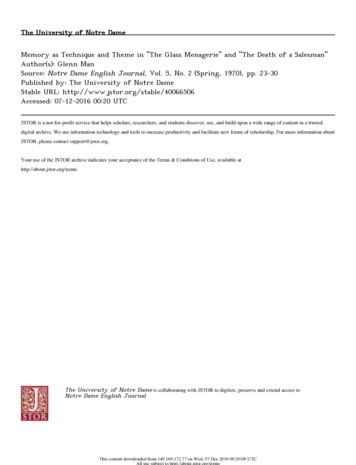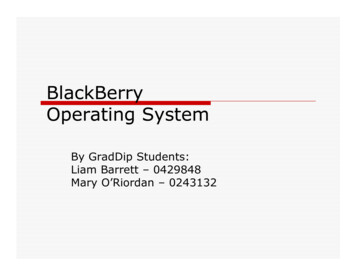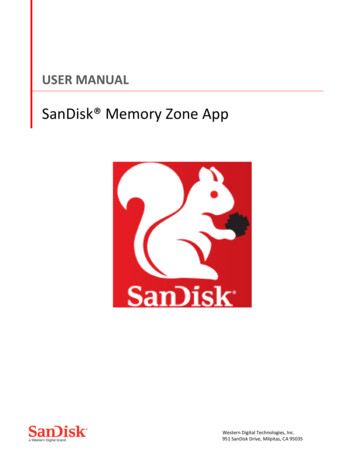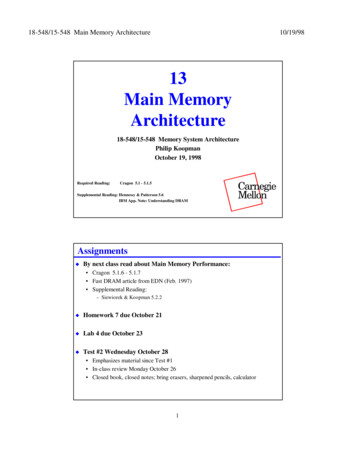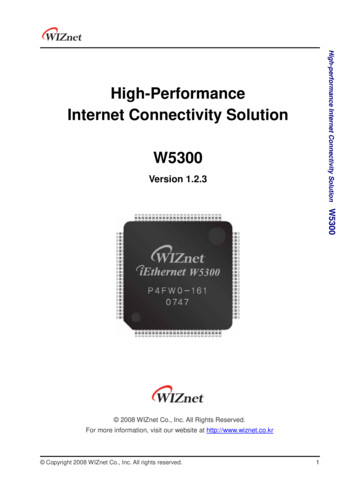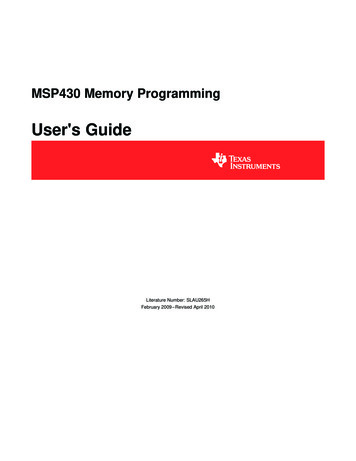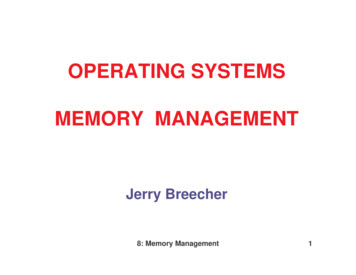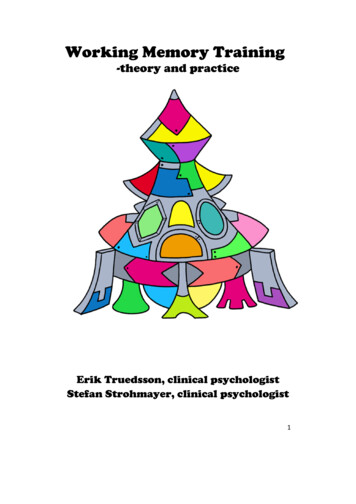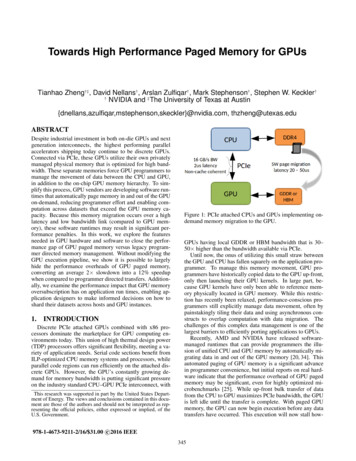
Transcription
Towards High Performance Paged Memory for GPUsTianhao Zheng†‡ , David Nellans† , Arslan Zulfiqar† , Mark Stephenson† , Stephen W. Keckler†† NVIDIA and ‡ The University of Texas at idia.com, thzheng@utexas.eduABSTRACTDespite industrial investment in both on-die GPUs and nextgeneration interconnects, the highest performing parallelaccelerators shipping today continue to be discrete GPUs.Connected via PCIe, these GPUs utilize their own privatelymanaged physical memory that is optimized for high bandwidth. These separate memories force GPU programmers tomanage the movement of data between the CPU and GPU,in addition to the on-chip GPU memory hierarchy. To simplify this process, GPU vendors are developing software runtimes that automatically page memory in and out of the GPUon-demand, reducing programmer effort and enabling computation across datasets that exceed the GPU memory capacity. Because this memory migration occurs over a highlatency and low bandwidth link (compared to GPU memory), these software runtimes may result in significant performance penalties. In this work, we explore the featuresneeded in GPU hardware and software to close the performance gap of GPU paged memory versus legacy programmer directed memory management. Without modifying theGPU execution pipeline, we show it is possible to largelyhide the performance overheads of GPU paged memory,converting an average 2 slowdown into a 12% speedupwhen compared to programmer directed transfers. Additionally, we examine the performance impact that GPU memoryoversubscription has on application run times, enabling application designers to make informed decisions on how toshard their datasets across hosts and GPU instances.1.INTRODUCTIONDiscrete PCIe attached GPUs combined with x86 processors dominate the marketplace for GPU computing environments today. This union of high thermal design power(TDP) processors offers significant flexibility, meeting a variety of application needs. Serial code sections benefit fromILP-optimized CPU memory systems and processors, whileparallel code regions can run efficiently on the attached discrete GPUs. However, the GPU’s constantly growing demand for memory bandwidth is putting significant pressureon the industry standard CPU–GPU PCIe interconnect, withThis research was supported in part by the United States Department of Energy. The views and conclusions contained in this document are those of the authors and should not be interpreted as representing the official policies, either expressed or implied, of theU.S. Government.Figure 1: PCIe attached CPUs and GPUs implementing ondemand memory migration to the GPU.GPUs having local GDDR or HBM bandwidth that is 30–50 higher than the bandwidth available via PCIe.Until now, the onus of utilizing this small straw betweenthe GPU and CPU has fallen squarely on the application programmer. To manage this memory movement, GPU programmers have historically copied data to the GPU up-front,only then launching their GPU kernels. In large part, because GPU kernels have only been able to reference memory physically located in GPU memory. While this restriction has recently been relaxed, performance-conscious programmers still explicitly manage data movement, often bypainstakingly tiling their data and using asynchronous constructs to overlap computation with data migration. Thechallenges of this complex data management is one of thelargest barriers to efficiently porting applications to GPUs.Recently, AMD and NVIDIA have released softwaremanaged runtimes that can provide programmers the illusion of unified CPU and GPU memory by automatically migrating data in and out of the GPU memory [20, 34]. Thisautomated paging of GPU memory is a significant advancein programmer convenience, but initial reports on real hardware indicate that the performance overhead of GPU pagedmemory may be significant, even for highly optimized microbenchmarks [25]. While up-front bulk transfer of datafrom the CPU to GPU maximizes PCIe bandwidth, the GPUis left idle until the transfer is complete. With paged GPUmemory, the GPU can now begin execution before any datatransfers have occurred. This execution will now stall how-978-1-4673-9211-2/16/ 31.00 c 2016 IEEE345
a 12% speedup when compared to legacy programmerdirected transfers.ever and incur the page-fetch latency to transfer pages fromCPU to GPU memory before returning data to the computeunit (CU) which performed the first load or store to a previously unaccessed page.Despite PCIe latency being just several microseconds [30]the page fault and DMA-process (called far-faults henceforth) requires several PCIe round trips and significant interaction with the host CPU. Because GPUs do not have thecapability to handle page faults within the execution pipelinethemselves (as CPUs typically do today), the GPU offloadsGPU page table manipulation and transfer of pages to a GPUsoftware runtime executing on the CPU. The end-to-end costof this process may range from as much as 50 microsecondsto as little as 20 microseconds depending on the exact implementation, as shown in Figure 1. For a simple scheme inwhich the faulting process merely DMAs data to the GPU,the overhead may be on the low end of this range. A morecomplex scheme where the software fault handler performssignificant CPU and GPU page table manipulations on thehost, before invalidating and updating the GPU resident pagetable, will be more expensive.While GPUs are noted for being memory-latency tolerant, access latencies extending into 10’s of microseconds,blocked behind far-fault handling, are orders of magnitudelarger than latencies to the local memory system. Becauseof this, paged memory GPU implementations are likely tosee significant performance degradation as a byproduct ofthis improved programming convenience. However, if theseperformance overheads can be hidden, GPU paged memoryhas the potential to improve both programmer productivityand performance, as well as enable GPU computation acrossdatasets that exceed the physical memory capacity of theGPU. In this work we attempt to quantify the performanceimpact of GPU paged memory implementations and exploreboth hardware and software improvements that can mitigatethe impact of these high-latency paged memory transfers.The contributions of this work are the following:4. We evaluate the impact of GPU memory oversubscription on workload performance and show that for someworkloads oversubscription is likely to be utilized, butfor others oversubscription may be untenable, regardless of the paging policies employed.2.MOTIVATION AND BACKGROUNDGPUs have become the de facto standard for parallel program acceleration because of their highly-threaded,throughput-oriented designs. Whereas traditional CPUshave relied on caches and low latency memory systemsto help improve single-threaded execution, GPUs typicallyforgo large caches and instead rely on multithreading to hidememory system latency. As a consequence of exposed longlatency memory operations, GPU programmers try to structure their algorithms to eliminate memory dependencies between threads. To scale performance, GPUs have historically increased both the numbers of threads per compute unitand added additional compute units (CU).As the number of GPU compute units and threads increases, memory bandwidth must also be scaled commensurately to keep these units fed. Despite GPU memory footprints and bandwidths continuously growing, the memorycapacity of GPUs remains relatively small compared to thecapacity of the CPU-attached memory system. Because ofthe separate physical memories the GPU and GPU operatewithin, data must be copied from CPU memory into GPUmemory before the GPU is able to access it.1 GPU programmers explicitly control this transfer and typically front-loadthe transfer of memory from host to device before GPU kernel execution to maximize PCIe bus efficiency.Current GPU programming models do provide the functionality to overlap data transfer and kernel execution, asin the CUDA streams programming model. However theCUDA streams model restricts GPU execution from accessing memory that is currently undergoing transfers. Restrictions like this increase the difficulty for programmers to tryand efficiently overlap memory transfers and kernel execution on GPUs. As a result, the dominant “copy then execute”model employed by most GPU programs effectively restrictsthe effective working set of the application to be GPU memory resident. On kernel completion, programmers must alsocopy the return data from the GPU to CPU, but the returneddata often has a significantly smaller footprint when compared to the pre-execution transfer.Figure 2 shows the effect of using a BW optimized frontloaded memory transfer, before kernel execution, for workloads from the Rodinia [12], Parboil [42], and DoE HPCsuites [11, 19, 32, 45]. As others have observed, this memorytransfer overhead is an important aspect to consider whenquantifying GPU performance [18]. For many kernels, datamigration overhead may match or even dominate kernel execution time. As GPU compute capabilities improve the relative overhead of memory transfers to execution time willgrow. Simultaneously, improved CPU–GPU interconnects1. We show that under the existing GPU compute unit(CU) model, blocking paged memory fault handlingwill not be competitive with programmer controlledmemory management, even if far-fault latency is reduced to an unrealistic 5 microseconds.2. We propose a compute unit agnostic page fault handling mechanism (called replayable far-faults) thattreats far-faults as long latency memory operationsrather than execution exceptions. This allows CUs tocontinue issuing instructions from available warps aslong as they are not also blocked on pending far-faults.We show that allowing just a small number of simultaneous outstanding far-faults per CU can reduce the impact of GPU paged memory from a 3.6 to 2 slowdown.3. We show that even with replayable far-faults, PCIebandwidth is often underutilized and intelligentprefetching is required to maximize CPU–GPU memory transfer bandwidth. We provide a simple softwareprefetcher implementation that performs within 3% oforacular prefetching and is able to improve the performance of GPU paged memory from a 2 slowdown to1 While it is possible to access memory directly over PCIe this israrely done in practice.2346
Figure 2: Workload execution time breakdown includingdata transfer overhead, kernel execution time, and potentialspeedup if copy and execution could be perfectly overlappedin time.Figure 3: The effect of improving the page-handling latencyof far-faults on a GPU that blocks compute units on pagefault handling.GPUs do not support context switching to operating system service routines, thus page-faults that can be resolvedby migrating a physical page from the host to the devicecannot be handled in-line by the GPU compute units, asthey would be on a CPU today. Instead the GPU’s MMU(GMMU) must handle this outside of the compute unit, returning either a successful page translation request or a fatal exception. Because the GMMU handling of this pagefault actually invokes a software runtime on the host CPU,the latency of completing this handling is both long (10’sus) and non-deterministic. As such, GPUs may choose toimplement page-fault handling by having the GMMU stopthe GPU TLB from taking new translation requests untilthe SW runtime has performed the page migration and theGMMU can successfully return a page translation. Undersuch a scenario, each individual CU could be blocked formany microseconds while its page fault is handled, but othernon-faulting compute units can continue making progress,enabling some overlap between GPU kernel execution andon-demand memory migration.Figure 3 shows the application run time of using sucha paged memory design compared to programmer directedtransfer under a sweep of possible page-fault handling latencies. Though compute units are now able to continuously execute stalling only for their own memory dependencies, thisimprovement appears to be subsumed by the additional overhead of performing many small on-demand memory transfers rather than a single efficient up-front transfer. On realGPUs, the load latency for the first access to a page when using paged GPU memory implementations ranges from 20µs(NVIDIA Maxwell) to 50µs (AMD Kaveri), though the exact steps occurring that contribute to this latency are not documented.Thus using 20µs as an optimistic lower bound on SWcontrolled page fault latency, applications employing pagedGPU memory may see slowdowns of up to 15 comparedto programmer directed memory transfers, with an averageslowdown of 6 . Even if page fault latencies could be reduced to 5us, the performance impact of on-demand paging would still result in nearly a 2 average slowdown ver-such as faster versions of PCIe and next generation interconnects like NVIDIA’s NVLink [35] will reduce memorytransfer times. As a result, workloads are likely to continuehaving a variety of balance points between kernel executionand memory transfer overheads.In the commonly used programmer directed memorytransfer model, the transfer and execute phases of a GPU application are typically serialized, resulting in execution timethat is the sum of these costs. The paged memory models recently provided by GPU vendors, not only improvedprogramming convenience, but they also have the potentialto improve performance by overlapping these applicationphases. Programmatically, these runtimes allow applicationprogrammers to simply allocate memory as needed and thesoftware runtime will actively transition pages between theCPU and GPU when required for execution to proceed. Figure 2 shows, in green, the theoretical performance improvement achievable if the memory transfer and kernel executionphases could be perfectly overlapped with no dependence.For applications in which either kernel execution or memory transfer dominates the run time, there is little room forperformance improvement through overlapping. But, for applications with balanced execution and transfer, efficient ondemand paged memory implementations may be able to actually improve performance beyond that of legacy programmer directed transfers by as much as 49%.2.1Supporting On-Demand GPU MemoryDespite using an identical interconnect, on-demand pagedGPU memory can improve performance over up-front bulkmemory transfer by overlapping concurrent GPU executionwith memory transfers. However, piecemeal migration ofmemory pages to the GPU results in significant overheadsbeing incurred on each transfer rather than amortized acrossmany pages in an efficient bulk transfer. Because pageablememory is a new feature in GPUs the concept of a validphysical page, which is not already present in GPU memory,is a new addition to the GPU’s microarchitectural memorymodel.3347
GPU1 CU accesses memory locationcausing TLB miss2 TLB miss is relayed to GMMU3 Page is not present (far-fault).GMMU allocates MSHR entry4 GMMU sends ‘NACK-replayable’message to requesting TLB5 CPU is interrupted to handle pagemigration & page table update1CUTLBL12CUCUTLBTLBL1L1Far-fault MSHRsCPU3GMMU465GPU page faultruntime/driverL26 Page migration complete. GMMUnotifies TLB to replay requestGDDR / HBMDDR4Figure 4: Architectural view of GPU MMU and TLBs implementing compute unit (CU) transparent far page faults.sus programmer controlled memory transfers. While pagedmemory handling routines undoubtedly will continue to improve, PCIe’s 2µs latency combined with multiple roundtrips for CPU–GPU communication makes it extremely unlikely that CPU based GPU page fault resolution will everbecome faster than 10µs indicating that alternatives to simply speeding up page-fault latencies need to be examined toenable high performance GPU paged-memory.This paper explores two techniques that hide on-demandGPU page fault latencies rather than trying to reduce them.For example, we can potentially hide page fault latency bynot just decoupling GPU CUs from each other under pagefaults, but by allowing each CU itself to continue executing in the presence of a page-fault. GPUs are efficient inpart because their pipelines are drastically simplified and donot typically support restartable instructions, precise exceptions, nor the machinery required to replay a faulting instruction without side effects [29]. While replayable instructionsare a common technique for supporting long latency pagingoperations on CPUs, this would be an exceptionally invasive modification to current GPU designs. Instead, we explore the option of augmenting the GPU memory system,which already supports long latency memory operations, togracefully handle occasional ultra-long latency memory operations (those requiring page fault resolution) in Section 3.In Section 4, we show that in addition to improving CUexecution and memory transfer overlap, aggressive pageprefetching can build upon this concurrent execution modeland eliminate the latency penalty associated with the firsttouch to a physical page.3.being resolved, the GMMU may choose to pause the CUTLB from accepting any new memory requests, effectivelyblocking the CU. Alternatively, to enable the CU to continueexecuting in the presence of a page-fault (also called far-faultto distinguish it from a GMMU translation request that canbe resolved in local-memory), both the CU TLB and GMMUstructures need to be extended with new capabilities to trackand replay far-faulting page translation requests once theyhave been handled by the software runtime, a capability werefer to as “replayable faults”.Figure 4 shows a simplified architecture of a GPU thatsupports ‘replayable’ page faults. 1 Upon first access toa page it expects to be available in GPU memory, a TLBmiss will occur in the CU’s local TLB structure. 2 Thistranslation miss will be forwarded to the GMMU which performs a local page table lookup, without any indication yetthat the page may be valid but not-present in GPU memory.Upon discovering that this page is not physically present,the GMMU would normally return an exception to the CUor block the TLB from issuing additional requests. To enable the CU to continue computation under a page fault, ourproposed GPU’s GMMU employs a bookkeeping structurecalled ‘far-fault MSHRs’ (see Figure 4) to track potentiallymultiple outstanding page migration requests to the CPU.3 Upon discovery that a translation request has transitionedinto a far-fault, the GMMU inserts an entry into the far-faultMSHR list. 4 Additionally,the GMMU also sends a new’Nack-Replayable’ message to CU’s requesting TLB. ThisNack response tells the CU’s TLB that this particular faultmay need to be re-issued to the GMMU for translation ata later time. 5 Once this Nack-Replayable message hasbeen sent, the GMMU initiates the SW handling routine forpage fault servicing by putting its page translation request inmemory and interrupting the CPU to initiate fault servicing.6 Once the page is migrated to the GPU, the correspondingentry in the far-fault MSHRs is used to notify the appropriateTLBs to replay their translation request for this page. Thistranslation will then be handled locally a second time, successfully translated, and returned to the TLB as though theoriginal TLB translation request had taken tens of microseconds to complete.This far-fault handling routine is fully transparent to theGPU CU, the warp that has generated the fault is descheduled until the time its memory request returns. As a re-ENABLING COMPUTE UNITEXECUTION UNDER PAGE-FAULTSIn Section 2 we showed that allowing GPU compute unitsto execute independently, stalling execution only on theirown page faults, was insufficient to hide the effects of longlatency page fault handling. Because the GPU compute unitsare not capable of resolving these page faults locally, theGMMU must interface with a software driver executing onthe CPU to resolve these faults, as shown in Figure 4. Because this fault handling occurs outside the GPU CU, theyare oblivious that a page-fault is even occurring. To preventoverflowing the GMMU with requests while a page-fault is4348
SimulatorGPU ArchGPU CoresL1 CachesL2 CachesL2 MSHRsPer CU TLBssult, within the CU all warps that are not waiting on theirown fault can continue to execute. Because all TLB missescan potentially turn into far-faults, one might think thatthe GMMU should implement as many far-fault MSHRs asthere are CU TLB entries. However, these additional entriesdo not add to the GPU’s TLB reach like normal TLB entriesmaking them logically more expensive to implement.Instead, the GMMU can implement a smaller number offar-fault MSHRs and rely on the Nack-Replayable mechanism to force replay of TLB translation requests for which ithas not initiated the SW page faulting process nor is tracking. For example, if the GMMU supports just two concurrent far-faults per CU, a third in-flight translation requestwill turn into a far-fault. The GMMU can then drop this request and issue the Nack-Replayable to the TLB. This marksthis request as needing replay.Because the TLB knows the supported number of far-faultMSHRs for each CU, the TLB simply maintains a counter ofhow many far-fault Nack-Replayable messages it has pending. If it receives a Nack that pushes this count above theGMMU threshold, it now knows that this translation requestis not being handled and it will have to replay this translation once a GMMU pending far-fault has been resolved.The Nack-Replay mechanism effectively implements a farfault request throttling mechanism under which the GPUCU can continue execution for TLB hits and page translation requests that can be resolved locally by the GMMUhardware page walk unit. Under this architecture, there isnow a critical design trade-off to determine the number ofGMMU far-fault MSHRs that must be supported to enableCU’s to continue execution under the presence of replayablefar-faults without backing up into the CU TLB and blockingnon-faulting warps from performing the necessary addresstranslation.3.1GMMUGPU GDDR5DRAM TimingsCPU–GPUInterconnectGPGPU-Sim 3.xNVIDIA GTX-480 Fermi-like15 CUs @ 1.4GHz16kB/CUMemory Side 128kB/DRAM Channel128 Entries/L2 Slice128-entry, 4-port, per CU TLBsupporting hit under missLocal page walk supported by8KB 20-cycle latency PW-cacheMemory system12-channels, 384GB/sec aggregateRCD RP 12,RC 40,CL WR 12PCIe 3.0 X16, 16GB/sec20µs far-fault service timeTable 1: Simulation parameters for GPU supporting ondemand paged GPU memory.threaded GMMU page walk and per CU TLB implementation is based largely on those proposed by Pichai et al. [38]and Power et al. [39]. These groups have shown that a highlythreaded GMMU page walker and 128 entry, 4-port perCU TLB supporting hit-under-miss is able to achieve performance within 2% of an idealized TLB design for mostworkloads. Our workload footprints vary between 2.6MBand 144MB with an average footprint size of 43MB. Whilethese footprints are smaller than contemporary GPU memories they are non-cache resident, thus depending heavily onthe GPU memory system to achieve good performance. Additionally, as shown in Figure 2 memory transfer time dominates the GPU execution time for half of these workloads.We extend GPGPU-Sim [5] with our GMMU memorymodel as shown in Table 1. It should be noted that we extendthe baseline GTX-480 model to better match the bandwidthand compute capabilities of modern GPUs (e.g. increasingthe number of miss status handling registers and increasingclock frequency on both CUs and memory). Although theexact steps involved during the page migration process between CPU and GPU memories are undisclosed, we estimate software managed page faults to take somewhere between 20µs and 50µs. We model an optimistic 20µs farfault handling latency in the rest of our evaluations assumingthat software page fault implementations will continue to beoptimized over time thus trending to the lower end of thisrange.MethodologyTo evaluate the performance impact of our replayable farfaults within a paged GPU memory, we model a hypothetical GPU with the ability of the GMMU to track and trigger far-fault page migrations from the CPU to the GPU asshown in Figure 4. Under the on-demand paged GPU memory model, all pages initially reside in CPU memory at thebeginning of kernel execution. Upon first access to a pageby the GPU, the TLB will miss causing the GMMU to issuea far-fault to the CPU to migrate the page to GPU memory.In this case, the warp that has missed in the TLB will bestalled, but all other warps within the CU can continue to issue and be serviced by both the TLB and cache and memoryhierarchies pending availability of those microarchitecturalresources. When the GMMU interrupts the CPU to signala page-fault we also assume that the SW fault handler willdrain the GMMU pending fault queue if there are multiplefaults available in a polled fashion. This is a common technique used in device drivers to hide interrupt latency andoverhead for devices that signal the CPU at high rates.We have sized our GPU TLB structures aggressively totry and understand the performance impact of far-misses onGPU paged memory when compared to TLB implementations that provides near ideal performance for applicationsthat execute resident within GPU memory. Our local multi-3.2Experimental ResultsFigure 5 shows the performance comparison of ondemand paged GPU memory when varying the number ofper CU concurrent GMMU far-faults. Although some applications such as nw and sgemm show little sensitivity tosupporting multiple outstanding far-faults per-CU, the majority of applications see significant performance gains ifthe GMMU supports multiple pending far-faults per-CU indicating that allowing CUs to continue executing under apending page fault is an important microarchitectural featurefor paged-memory GPUs to support. While we do not esti5349
mary impact of this will be in the porting and number ofentries required in the TLB to not limit performance. Because we have assumed an aggressive design for our per CUL1 TLBs, their performance is already near ideal, movingto virtual-virtual L1 caches should result in little applicationperformance change in our simulated GPU. Despite the performance improvement seen when supporting multiple outstanding faults the performance of our proposed paged memory implementation is still 2–7 worse than programmer directed transfers for half of our applications indicating thatthere are further inefficiencies in the paged memory designthat need to be explored. We present further optimizationsin Section 4 aimed at closing this performance gap.4.PREFETCHING GPU PAGED MEMORYIn Section 3 we explored the performance improvementsof enabling the GPU memory system to hide pendingsoftware-handled page faults from the GPU CUs. By augmenting the TLB and GMMU to allow for multiple pending far-faults, we are able to reduce the performance overhead of paged GPU memory by nearly 45% compared tosupporting just a single outstanding far-fault. This improvement comes strictly from enabling additional overlappingof data migration and computation and not from improving the page-fault latency itself. However, even with thisimprovement our paged memory implementation still has a 100% performance overhead compared to programmer directed data transfers. To understand where the remainingoverhead is rooted, we examined the PCIe bus traffic generated by our replayable far-fault architecture using multiplepending on-demand faults.Figure 6 shows the PCIe bandwidth utilization of ourworkloads as a function of normalized application run time.For each application if the line is below 1.0 it means that itis underutilizing the PCIe bus. We see that only a few applications are able to generate enough on-demand requeststo fully saturate the available PCIe bus at any time duringexecution and the average bandwidth utilization being just25% across all application’s run times. Programmer controlled memory transfers, on the other hand, are able to transfer their datasets to the GPU at nearly full PCIe bandwidthwhen utilizing efficient up-front memory transfers. This ondemand underutilization provides an opportunity to speculatively prefetch pages across PCIe with little opportunitycost. Successful prefetching of pages will result in the firsttouch to a page incurring only TLB miss that can be resolvedlocally by the GMMU, rather than being converted into a farfault. Thus, a successful prefetch removes the far-fault overhead from the application’s critical path, improving averagememory latency and freeing up TLB and GMMU far-faultMSHR resources to handle other on-demand faults.Figure 5: Workload runtime (lower is better) as a function ofnumber of supported GMMU far-faults (per CU).mate the area impact of our GMMU far-fault MSHRs, thisstructure essentially duplicates the per CU L1 MSHR entrieswithout providing any additional TLB reach.Because the GMMU MSHR structure size is the unionof all per CU entries that are awaiting far-faults, supportinga large number of entries in the far-fault MSHR structurecan be expensive. At application startup, when most TLBmisses are likely to be translated into far-faults, supporting alarge number of GMMU far-fault MSHRs is ideal, but oncemost GPU accessed pages are on the GPU, these MSHRs arelikely to go underutilized. Therefore, we would like to minimize the total number of entries required in this structureas much as possible. Fortunately, our evaluations show thattracking only four in-flight far-faults per-CU at the GMMUis sufficient to sustain good performance and there is littlereason to go beyond 16 in flight faults per CU. While it isconceptually possible to allow the GMMU to simply use thestate information available at the per-CU TLBs without requiring separate far-fault MSHRs; allowing the centralizedGMMU to have direct access into all T
the GPU and CPU has fallen squarely on the application pro-grammer. To manage this memory movement, GPU pro-grammers have historically copied data to the GPU up-front, only then launching their GPU kernels. In large part, be-cause GPU kernels have only been able to reference mem-ory physically lo
